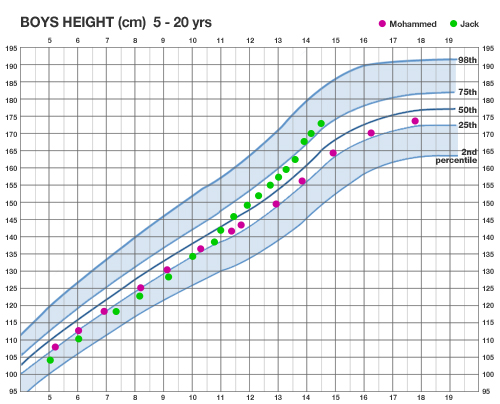Over the years, the average height for men and women has changed substantially. Some people reach their maximum limit at a young age. Others take more time before they make it to the potential height.
Nutrition and other health factors may cause stature differences among various populations. Immigration may also influence the average height of a person.
In 2010, the average American man was 176 cm(around 69.3 inches) tall. A century ago, the average American man’s height was 170 cm (about 67 inches). Although this marks a growth of more than 2 inches, the rate at which Americans are growing has slowed relative to other nations (source). In 1896, American men ranked as the third tallest in the world. Since then, they’ve slipped to 37th place in height. This is because other nations are growing more rapidly while American height growth is slowing down. Studies show that those nations that have experienced more significant improvements in health and nutrition have also grown taller. The table below includes 2016 data. It shows average heights for men in 15 countries born between 1918 and 1996. The chart is based on an analysis of hundreds of population-based studies. According to the 2015-2016 study, the average height for American men is 175.4 centimeters (about 5 feet 9 inches). An analytic sampling includes 47,233 men and women at least 20 years of age. The participants reported their characteristics like race, age, region, and whether they were of Spanish/Hispanic origin. The average height of 175.4 centimeters (5 feet 9 inches) considers all groups (source). Over the past decades, American children have come across fewer growth-stunting nutritional issues or health problems, so they have grown taller. Since this health improvement has persisted for the last 20 years, children are no longer growing taller than their parents. The human height is 60 to 80% heritable, which means the difference in height between people is due to genetic factors. This indicates that genetics influences the height differences between individuals living in environments that offer quality nutrition and little exposure to disease (source). In more challenging conditions, factors like diet and exposure to disease can considerably affect stature. Causes other than genetics that can affect height are: Medical conditions such as diabetes, kidney failure, cardiovascular disease, and cancer can affect height. A handful of other states can also cause extremes in height. SED results in shorter than the average trunk. It’s also a genetic problem, but it is often not diagnosed until middle childhood (source). Achondroplasia is a medical disorder that results in short legs and arms. It is also the leading cause of dwarfism. Those with achondroplasia average about 48 inches tall (source). Diastrophic dysplasia is an unusual genetic form of dwarfism that shortens the calves and forearms. Individuals with dwarfism may experience a variety of health issues (source). Children suffering from adenoma, a pituitary gland tumor, may secrete growth hormones excessively. This causes them to grow much taller. Gigantism results from a pituitary tumor, though some rare medical disorders can also cause excessive growth. These include: Those who are abnormally tall are also at risk of many health problems. Their extreme size can strain the metabolic system and cause cardiovascular problems, including an enlarged heart (source). Height and weight are connected in terms of health. A healthy body mass index (BMI) determines healthy body weight for your height. This means that one person could be measured as severely obese, and another could be underweight if they had different heights while weighing remains the same. A healthy BMI is in the 18.5 to 24.9 range. BMIs between 25 and 29.9 are marked as overweight, while a BMI over 30 indicates obesity. A BMI below 18.5 is categorized as underweight. For an average man with a stature of 175.26 cm, a healthy weight is between 128 and 168 pounds (source). People with too low or high BMIs are vulnerable to various medical illnesses, including cardiovascular disease, diabetes, and metabolic syndromes. For adults, BMI helps you to figure out if you are at a healthy weight for your height. It is an easy way to measure body weight. On the other hand, your doctor can provide you with more personalized information and help you to create a diet and exercise plan. Eat healthy food, stay hydrated, and exercise daily to maximize your fitness.
Average Height For Men By Country
Country
Average Male Height In Feet, Inches, Centimeters
The Netherlands
5 ft 1.9 in (182.5 cm)
Germany
5 ft 10.8 in (179.9 cm)
Australia
5 ft 10.6 in (179.2 cm)
Canada
5 ft 10.1 in (178.1 cm)
United Kingdom
5 ft 9.9 in (177.5 cm)
Jamaica
5 ft 8.7 in (174.5 cm)
Brazil
5 ft 8.3 in (173.6 cm)
Iran
5 ft 8.3 in (173.6 cm)
China
5 ft 7.6 in (171.8 cm)
Japan
5 ft 7.2 in (170.8 cm)
Mexico
5 ft 6.5 in (169 cm)
Nigeria
5 ft 5.3 in (165.9 cm)
Peru
5 ft 5 in (165.2 cm)
India
5 ft 4.9 in (164.9 cm)
The Philippines
5 ft 4.25 in (163.2 cm)
Average Height For Men in US
Factors Affecting The Height:
Health Conditions That Cause Extremes In Height
Spondyloepiphyseal dysplasias (SED):
Achondroplasia:
Diastrophic Dysplasia:
Pituitary Tumors:
Relationship Between Height And Weight:
The Bottom Line

